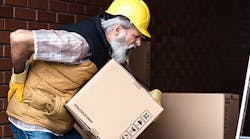Today’s mechanized solutions address many demands associated with labor-intensive jobs. So it would make sense that stressors associated with manual material handling would be reduced. However, engineers often target easy-to-automate tasks, and leave the difficult-to-automate tasks for the human. In doing so, the physical demands associated with smaller material handling tasks continue to be overlooked.
Reports from the Fourth European Working Conditions Survey show that 35% of workers are still exposed to manual material handling tasks for at least 25% of their shift time. For example, if an automotive mechanic pulls engines using a lift assist and then manually handles smaller parts, there is still exposure to stressors.
Whether immediate or long-term, injuries resulting from smaller tasks are as serious as they are expensive. The time lost, cost to the company and significance to the worker are undeniable. In fact, overexertion injuries account for nearly $14 billion annually in lost time, insurance and medical bills. To put this in perspective, upper-extremity musculoskeletal disorders (MSDs) generally cost between $27,000 and $33,000 to treat, and lower back injuries between $22,000 and $76,000.
There is also substantial impact to the worker’s future day-to-day activities and quality-of-life years. In some cases, an MSD can even force people into early retirement. By identifying high-risk tasks, and fitting the job to the worker, the incidence of MSDs resulting from lifting tasks can be greatly reduced.
Using the right risk assessment tool for the job, ergonomists and industrial safety engineers can assess a multitude of tasks performed in a variety of work environments. There is no one-size-fits-all solution, and knowing what tools are available and how to apply them enables professionals to increase the validity of their assessments; this helps deliver the best recommendations without wasting time or money, and reduces the incidence of otherwise preventable injuries.
The National Institute of Occupational Safety and Health (NIOSH) developed a lifting equation in the 1980s, which was revised in 1994 and is now one of the most widely used risk assessment tools to assess manual material handling in the field of ergonomics. Referred to as the Revised NIOSH Lifting Equation (RNLE), it is used along with the Composite Lifting Index (COLI/CLI), the Sequential Lifting Index (SLI), the Cumulative Lifting Index (CULI), and the Variable Lifting Index (VLI) to assess lifting tasks within four specific categories: single-task manual lifting, multiple-task manual lifting, sequential-task manual lifting, and variable-task manual lifting.
SINGLE-TASK MANUAL LIFTING
Single-task manual lifting is limited to monotonous jobs that either don’t occur often or are repetitive but do not vary in character over time. Jobs like these may involve moving an individual box from a shelf to a table, or repetitively lifting an object from point A to point B on an assembly line. Single-task manual lifting jobs are best assessed using the Revised NIOSH Lifting Equation, which identifies risk for lower back pain.
The RNLE results in a recommended weight limit (RWL), defined as the weight of a lift that nearly all healthy workers can perform over a period of time. The RWL is used to calculate a Lifting Index, which tells us how likely a given lift is to produce lower back pain in most individuals who perform the task. Using the RNLE, we can assign weight limits to lifting tasks and prevent the development of lower back pain and injury.
The RNLE does not apply to single-handed lifts, lifting/lowering for over 8 hours, seated or kneeling lifts, restricted workspaces, unstable objects, pushing/pulling/carrying, wheelbarrow lifting, high-speed lifting, extreme temperatures, or poor floor coupling. The RNLE considers physical strain as equal for tasks lasting 2 to 8 hours, and it does not compile daily physical exposures from job rotation. Nor does it provide a Lifting Index for tasks lasting longer than 8 hours. Thus, as effective as it is for monotonous two-handed lifts, it is limited to single-task manual lifting.
MULTIPLE-TASK MANUAL LIFTING
Multiple-task manual lifting jobs consist of 10 or fewer unique, repetitive lifting tasks that occur within the same shift at the same workstation; for example, palletizing jobs involving lifting boxes from several different totes to varying locations on a pallet within the same space. For jobs like these, the Composite Lifting Index is the best tool to use.
The CLI was created to provide an accurate lower-back assessment for multiple-task jobs lasting between 2 and 8 hours. It accounts for the duration of multiple lifting tasks that are continuous and occur within a single job. For instance, a job that consists of two tasks (three hours of pallet stacking and two hours of product stocking) involves two distinct forms of lifting that occur for varying time periods within the shift. The CLI considers both physical stressors and the duration of exposure, and compiles the data to provide an overall risk score.
SEQUENTIAL MANUAL LIFTING
Sequential manual lifting occurs where workers rotate among several or many workstations during a single shift, and where a worker might perform different sets of lifting tasks at each of those stations. Each job rotation may have its own set of single- or multi-task lifting activities. This complex mode of manual lifting requires tools that can combine varying tasks of different durations to quantify exposure throughout the entire work shift. The Sequential Lifting Index and Cumulative Lifting Index were developed to assess sequential manual lifting jobs like these.
The SLI accounts for the fatigue of spinal muscles, which occurs over bouts of repetitive lifting. It is most effective at analyzing jobs that rotate high-intensity and low-intensity tasks in a cyclic manner, and it can be used to quantify risk for jobs representing this type of job rotation. It produces a recommended weight limit, which can be used to determine the weight limits for each task or rotation within the work shift.
The CULI is used to determine biomechanical stressors for entire work shifts when a worker rotates between two or more tasks within the shift itself. It takes data produced using the CLI and combines all tasks that occurred at all workstations. For example, three hours of pallet stacking with two hours of product stocking at one station represent a single workstation with two distinct lifting tasks. If a second workstation is added, the CULI combines data from both workstations into a single job. This would account for the variability in lifting, duration and the workstations themselves.
VARIBLE-TASK MANUAL LIFTING
These types of jobs involve highly variable lifts within a job or shift. Variable-task manual lifting is difficult to analyze due to unpredictable lifting sequences and the irregular nature of the lifting tasks themselves. Examples include baggage handling, grocery selecting, warehouse operations and small lot material delivery.
The Variable Lifting Index is an estimate of the overall physical demand of the job as a whole. It weighs frequency and is best used when there are many lifting tasks that don’t involve a pre-determined pattern of lifting. It is an adaptation of the RNLE and produces an index score between 1 and 6. The VLI is also flexible. Two approaches to data collection are available:
● The sampling approach uses point data collected during a shift for all lifts involved. This requires on-site manual data collection and is more accurate.
● The systematic organizational analysis approach uses data from production or sales records.
Using both approaches, the average lifting frequency and work/rest patterns are collected and analyzed.
The adaptations of the RNLE described above can provide a detailed evaluation of the specific situations found in widely varying manual material handling jobs. But before starting a detailed evaluation, it is generally useful to conduct a screening assessment. The RNLE can be effectively used for screening by examining the worst-case scenario. Sometimes it is necessary to analyze several potential worst cases to select the actual worst case. Use the worst posture and highest lifting weight situations for the RNLE.
For the frequency of lifting, consider all lifting tasks performed rather than just how often the worst-case lift is performed. If operators lift items of different weights, treat the analysis as if every box were the heaviest weight. For example, if a person is removing layers of boxes weighing 15 to 30 pounds each from a pallet, the worst-case lift scenario would likely be a 30-pound box, on the bottom row, in the center of the pallet. The person may only perform this worst-case lift once every 10 minutes, but he or she is lifting other boxes from the pallet an average of two times per minute.
Use the 30-pound box weight and the frequency of two times per minute to treat the worst-case lift as if it were the position for each of the lifts. This method will overestimate the risk in the job. If the lift is acceptable when evaluated in this manner, there is no need for continued analysis.
Brandon Beltzman, AEP, is an ergonomist with Humantech, a VelocityEHS solution, a provider of workplace ergonomics in production and assembly environments.
References
Colombini, D. (2013). Manual Lifting: A Guide to the Study of Simple and Complex Lifting Tasks (Boca Raton, FL). Taylor & Francis Group LLC.
Ergonomics: “New procedure for assessing sequential manual lifting jobs using the revised NIOSH lifting equation” (November 2007).
Eurofound: “Fourth European Working Conditions Survey” (December 2007).
Human Factors: “The Cumulative Lifting Index (CULI) for the Revised NIOSH Lifting Equation: Quantifying Risk for Workers With Job Rotation” (August 2016).
Human Factors: “Variable Lifting Index (VLI): A New Method for Evaluating Variable Lifting Tasks” (August 2016).
The Synergist: “The Case for Ergonomics, Communicating Value to Business Stakeholders” (November 2018).
US Department of Health and Human Services: “Applications Manual for the Revised NIOSH Lifting Equation” (January 1994).



